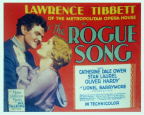|
  Tibbett is a Russian bandit king who falls in
love with a princess. Her brother has betrayed Tibbett's sister.
In revenge, he kills him, at the same time abducting the Princess. She
escapes, has him arrested and flogged, but then realizes that she loves him
after all. Tibbett is a Russian bandit king who falls in
love with a princess. Her brother has betrayed Tibbett's sister.
In revenge, he kills him, at the same time abducting the Princess. She
escapes, has him arrested and flogged, but then realizes that she loves him
after all.
Purely a vehicle for Metropolitan Opera star
Lawrence Tibbett, who was never to become a very satisfying screen
personality, Rogue Song was finished and ready for release when
Laurel & Hardy were added as an afterthought to give the film both
comedy relief and a measure of box-office insurance. They were billed
last in the cast without any kind of "guest star" status, and their
material, constructed neither by them nor by their standard Hal Roach
writers, was lame, obvious stuff. Lionel Barrymore, a good but stolid
director of straight dramatic fare, had neither the flair for Rogue Song
frou-frou nor for sight comedy, and undoubtedly could do nothing to help
them overcome the mediocrity of their material. Their footage was
spotted throughout the film, which received only moderate reviews for its
values as an operetta and no acclaim at all for its comedy. At best
the
Laurel & Hardy presence was noted and their comedy relief in a rather
turgid film appreciated.
However, critical appreciation of
Laurel & Hardy was late in arriving, and their mere presence in an
allegedly highbrow film of this nature may have been resented by many of the
critics, so quite possibly their sequences may have been a good deal better
than either memory or contemporary reviews indicate. This is only
conjecture, however, since no prints of the film are known to have survived.
MGM, the producing company, no longer has either a print or a negative of
the subject, decomposition having been hastened by the unstable nature of
the early Technicolor nitrate celluloid. If a print should suddenly
appear, it will be from an unlikely and unpredictable source, probably
European.
In the meantime, Rogue Song holds the
dubious distinction of being the only
Laurel & Hardy feature believed to be no longer in existence, and
while it is undoubtedly unrepresentative of the work, one would still give
much to see it again, since in it, presumably, once can trace the roots of
their own later burlesque operettas (Fra
Diavolo,
The
Bohemian Girl, Babes in Toyland) done very much under their own,
and Hal Roach's control. |
